Sundararaja D. The Discrete Fourier Transform. Theory, Algorithms and Applications
Подождите немного. Документ загружается.


344 The Bit-Reversal Algorithm
Table C.l A list of the decimal numbers from 0 to 15 and their bit-reversals.
Decimal
0
1
2
3
4
5
6
7
8
9
10
11
12
13
14
15
Binary
ri3n2Tiino
0000
0001
0010
0011
0100
0101
0110
0111
1000
1001
1010
1011
1100
1101
1110
1111
Bit-reversed
noT»lTl2«3
0000
1000
0100
1100
0010
1010
0110
1110
0001
1001
0101
1101
0011
1011
0111
1111
Bit-reversed
decimal
0
8
4
12
2
10
6
14
1
9
5
13
3
11
7
15
weight is greater than the number at any stage, we set the corresponding
bit to zero before we test with the next lower weight. This method will be
used in the bit reversal algorithm to test the bits in various positions.
The Bit-Reversed Order
If we express a set of decimal numbers in binary form, rewrite the bits of
each number in reverse order, and convert the resulting binary sequences to
decimal form, we get the bit-reversed order. Decimal numbers from 0 to 15
are shown in the first column of Table C.l. The second column shows the
binary representation of the numbers. The third column shows the binary
bits of the second column written in reverse order. The fourth column
shows the bit-reversed order of the decimal numbers. For example, the
binary representation of the decimal number 2 is 0010 and its bit-reversed
form is 0100 in binary and 4 in decimal. The in-place DFT algorithms
require the input to be in the bit-reversed order or generate the output
in that order. Therefore, we need the bit-reversed order of a set of N
consecutive integers starting from zero, where JV is a power of two.
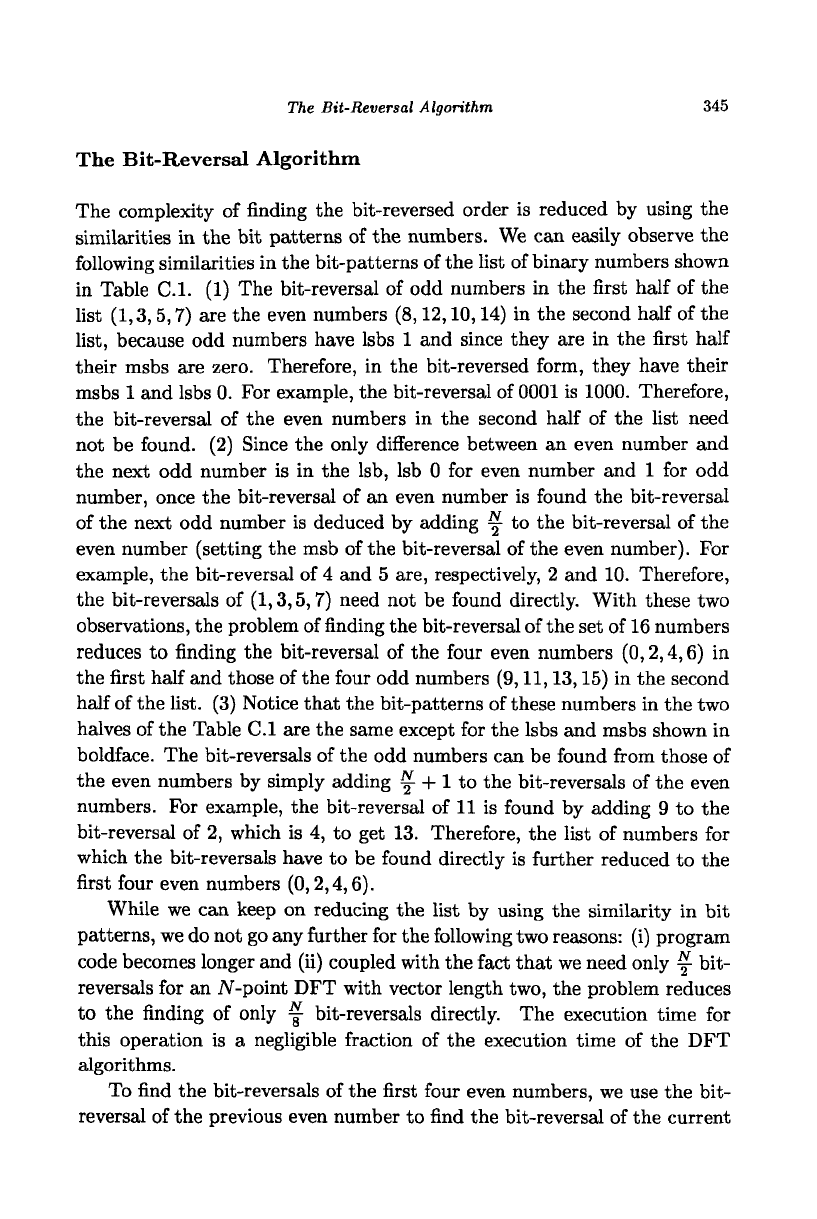
The Bit-Reversal Algorithm
345
The Bit-Reversal Algorithm
The complexity of finding the bit-reversed order is reduced by using the
similarities in the bit patterns of the numbers. We can easily observe the
following similarities in the bit-patterns of the list of binary numbers shown
in Table C.l. (1) The bit-reversal of odd numbers in the first half of the
list (1,3,5,7) are the even numbers (8,12,10,14) in the second half of the
list, because odd numbers have lsbs 1 and since they are in the first half
their msbs are zero. Therefore, in the bit-reversed form, they have their
msbs 1 and lsbs 0. For example, the bit-reversal of
0001
is 1000. Therefore,
the bit-reversal of the even numbers in the second half of the list need
not be found. (2) Since the only difference between an even number and
the next odd number is in the lsb, lsb 0 for even number and 1 for odd
number, once the bit-reversal of an even number is found the bit-reversal
of the next odd number is deduced by adding y to the bit-reversal of the
even number (setting the msb of the bit-reversal of the even number). For
example, the bit-reversal of 4 and 5 are, respectively, 2 and 10. Therefore,
the bit-reversals of (1,3,5,7) need not be found directly. With these two
observations, the problem of finding the bit-reversal of the set of 16 numbers
reduces to finding the bit-reversal of the four even numbers (0,2,4,6) in
the first half and those of the four odd numbers (9,11,13,15) in the second
half of the list. (3) Notice that the bit-patterns of these numbers in the two
halves of the Table C.l are the same except for the lsbs and msbs shown in
boldface. The bit-reversals of the odd numbers can be found from those of
the even numbers by simply adding ^ + 1 to the bit-reversals of the even
numbers. For example, the bit-reversal of 11 is found by adding 9 to the
bit-reversal of 2, which is 4, to get 13. Therefore, the list of numbers for
which the bit-reversals have to be found directly is further reduced to the
first four even numbers (0,2,4,6).
While we can keep on reducing the list by using the similarity in bit
patterns, we do not go any further for the following two reasons: (i) program
code becomes longer and (ii) coupled with the fact that we need only ^ bit-
reversals for an AT-point DFT with vector length two, the problem reduces
to the finding of only y bit-reversals directly. The execution time for
this operation is a negligible fraction of the execution time of the DFT
algorithms.
To find the bit-reversals of the first four even numbers, we use the bit-
reversal of the previous even number to find the bit-reversal of the current
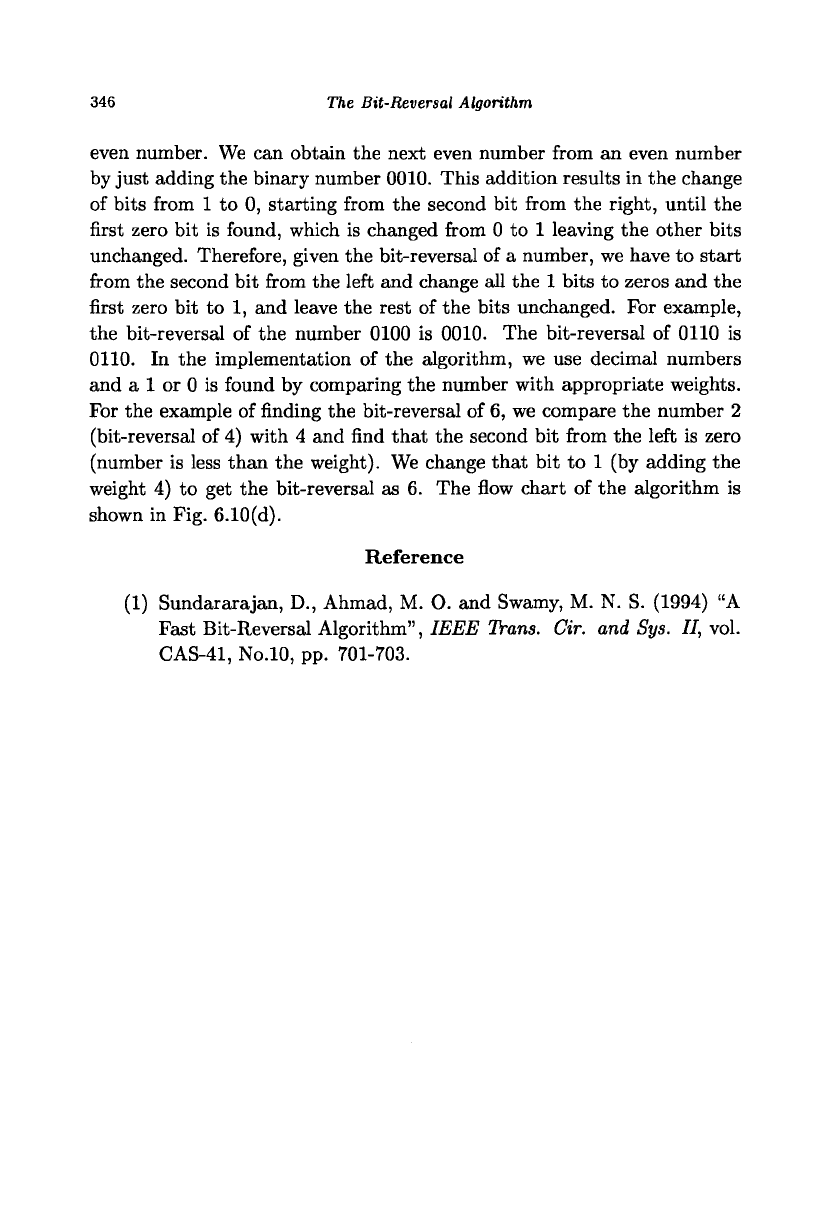
346 The Bit-Reversal Algorithm
even number. We can obtain the next even number from an even number
by just adding the binary number 0010. This addition results in the change
of bits from 1 to 0, starting from the second bit from the right, until the
first zero bit is found, which is changed from 0 to 1 leaving the other bits
unchanged. Therefore, given the bit-reversal of a number, we have to start
from the second bit from the left and change all the 1 bits to zeros and the
first zero bit to 1, and leave the rest of the bits unchanged. For example,
the bit-reversal of the number 0100 is 0010. The bit-reversal of 0110 is
0110.
In the implementation of the algorithm, we use decimal numbers
and a 1 or 0 is found by comparing the number with appropriate weights.
For the example of finding the bit-reversal of 6, we compare the number 2
(bit-reversal of 4) with 4 and find that the second bit from the left is zero
(number is less than the weight). We change that bit to 1 (by adding the
weight 4) to get the bit-reversal as 6. The flow chart of the algorithm is
shown in Fig. 6.10(d).
Reference
(1) Sundararajan, D., Ahmad, M. O. and Swamy, M. N. S. (1994) "A
Fast Bit-Reversal Algorithm", IEEE Trans. Cir. and Sys. II, vol.
CAS-41,
No.10, pp. 701-703.
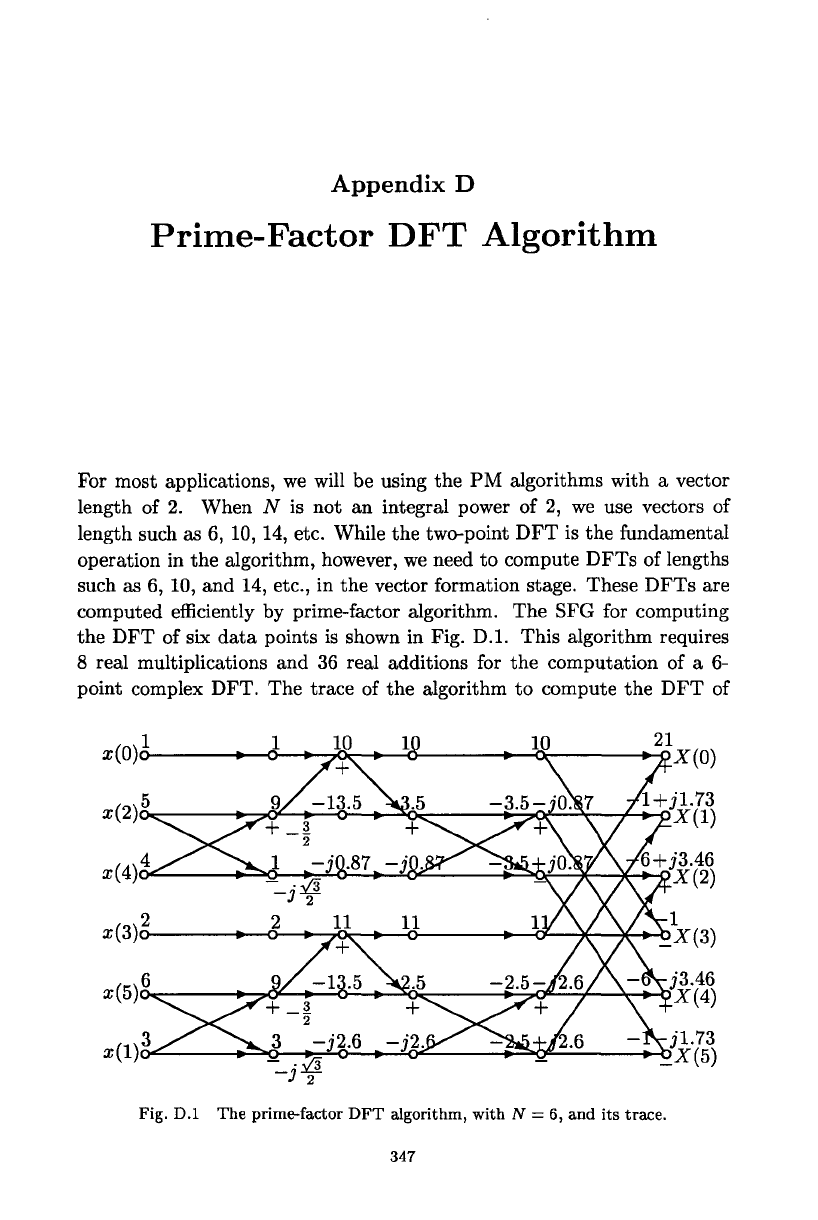
Appendix D
Prime-Factor DFT Algorithm
For most applications, we will be using the PM algorithms with a vector
length of 2. When N is not an integral power of 2, we use vectors of
length such as 6, 10, 14, etc. While the two-point DFT is the fundamental
operation in the algorithm, however, we need to compute DFTs of lengths
such as 6, 10, and 14, etc., in the vector formation stage. These DFTs are
computed efficiently by prime-factor algorithm. The SFG for computing
the DFT of six data points is shown in Fig. D.l. This algorithm requires
8 real multiplications and 36 real additions for the computation of a 6-
point complex DFT. The trace of the algorithm to compute the DFT of
Fig. D.l The prime-factor DFT algorithm, with N = 6, and its trace.
347
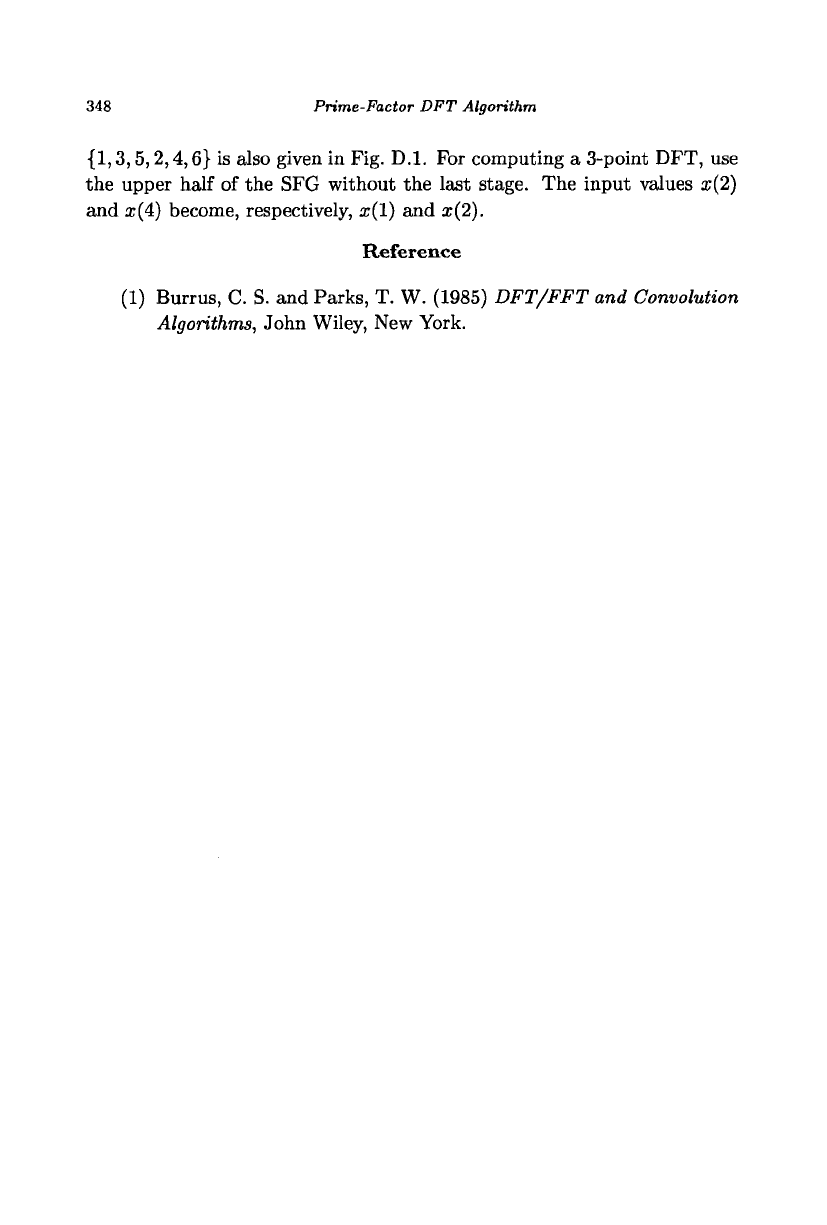
348 Prime-Factor DFT Algorithm
{1,3,5,2,4,6} is also given in Fig. D.l. For computing a 3-point DFT, use
the upper half of the SFG without the last stage. The input values x(2)
and a;(4) become, respectively, ar(l) and x(2).
Reference
(1) Burrus, C. S. and Parks, T. W. (1985) DFT/FFT and Convolution
Algorithms, John Wiley, New York.
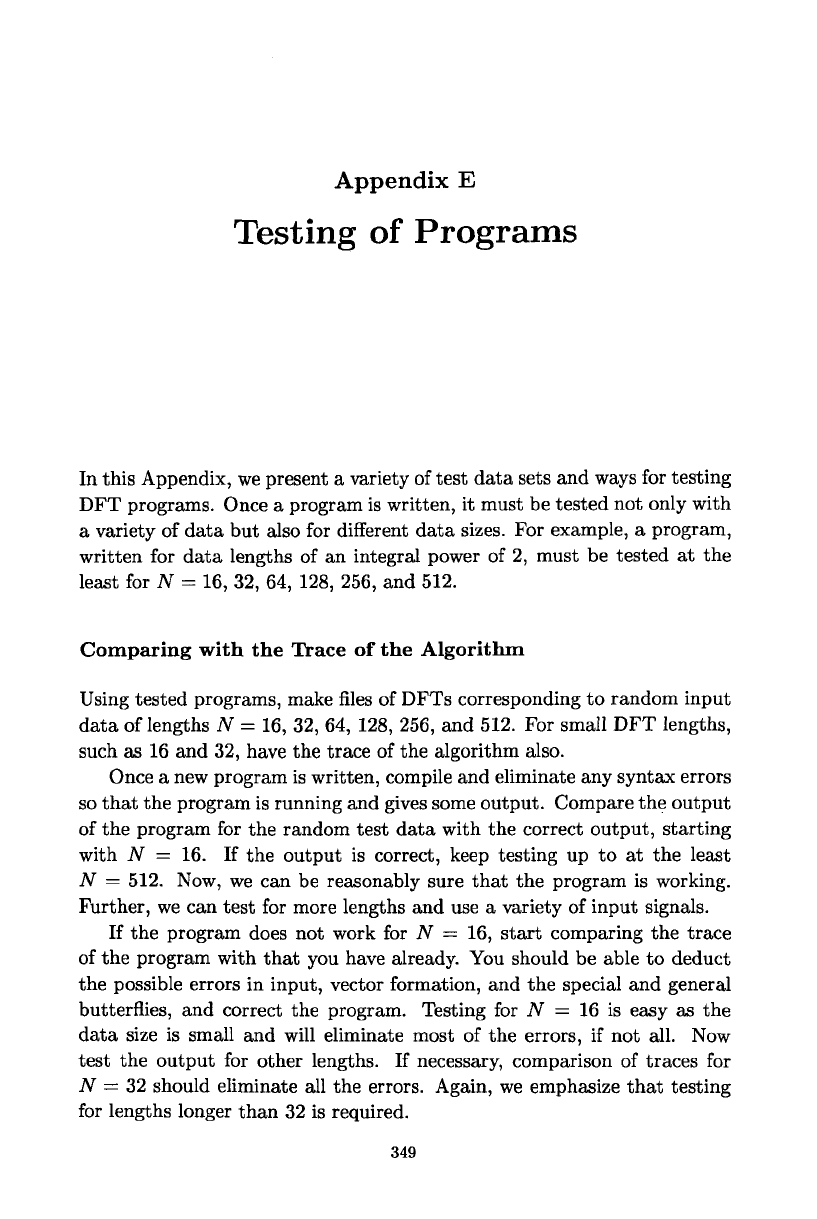
Appendix E
Testing of Programs
In this Appendix, we present a variety of test data sets and ways for testing
DFT programs. Once a program is written, it must be tested not only with
a variety of data but also for different data sizes. For example, a program,
written for data lengths of an integral power of 2, must be tested at the
least for N = 16, 32, 64, 128, 256, and 512.
Comparing with the Trace of the Algorithm
Using tested programs, make files of DFTs corresponding to random input
data of lengths N = 16, 32, 64, 128, 256, and 512. For small DFT lengths,
such as 16 and 32, have the trace of the algorithm also.
Once a new program is written, compile and eliminate any syntax errors
so that the program is running and gives some output. Compare the output
of the program for the random test data with the correct output, starting
with TV = 16. If the output is correct, keep testing up to at the least
N = 512. Now, we can be reasonably sure that the program is working.
Further, we can test for more lengths and use a variety of input signals.
If the program does not work for N = 16, start comparing the trace
of the program with that you have already. You should be able to deduct
the possible errors in input, vector formation, and the special and general
butterflies, and correct the program. Testing for N = 16 is easy as the
data size is small and will eliminate most of the errors, if not all. Now
test the output for other lengths. If necessary, comparison of traces for
N = 32 should eliminate all the errors. Again, we emphasize that testing
for lengths longer than 32 is required.
349
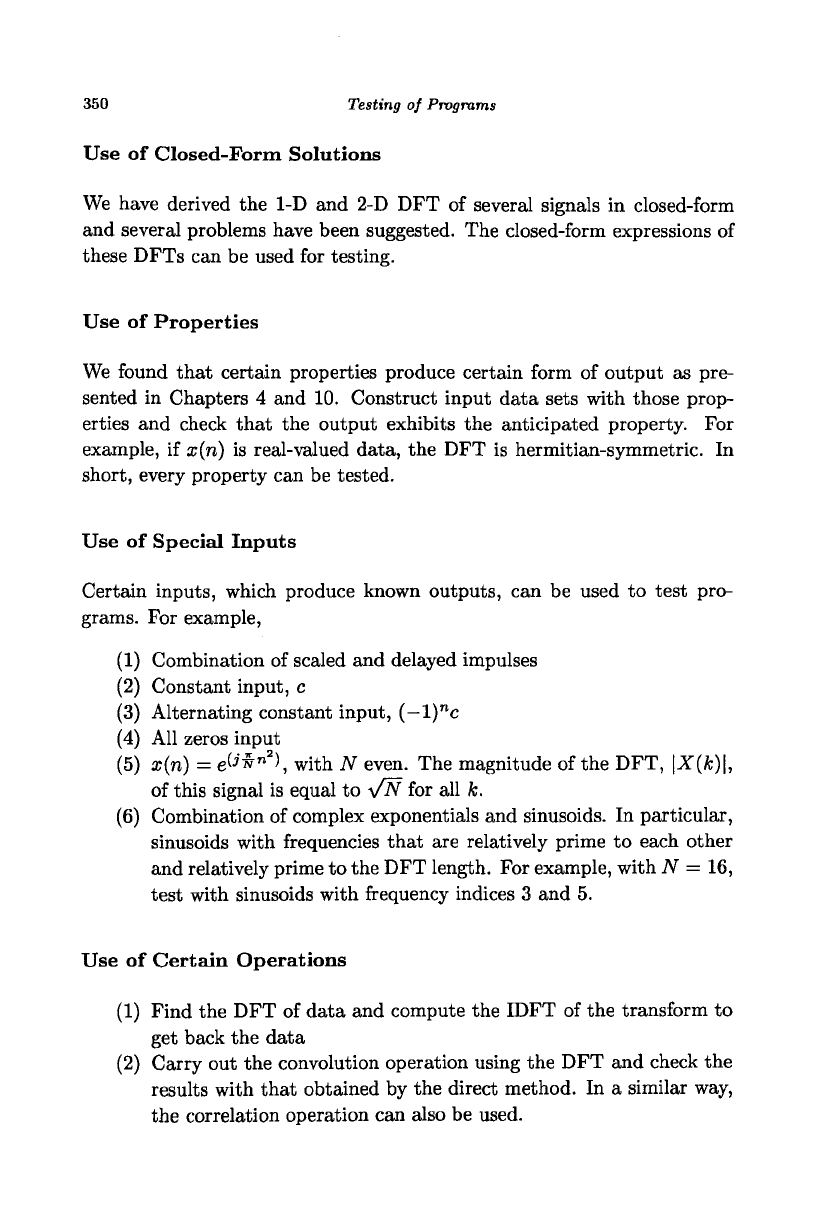
350
Testing of Programs
Use of Closed-Form Solutions
We have derived the 1-D and 2-D DFT of several signals in closed-form
and several problems have been suggested. The closed-form expressions of
these DFTs can be used for testing.
Use of Properties
We found that certain properties produce certain form of output as pre-
sented in Chapters 4 and 10. Construct input data sets with those prop-
erties and check that the output exhibits the anticipated property. For
example, if x(n) is real-valued data, the DFT is hermitian-symmetric. In
short, every property can be tested.
Use of Special Inputs
Certain inputs, which produce known outputs, can be used to test pro-
grams. For example,
(1) Combination of scaled and delayed impulses
(2) Constant input, c
(3) Alternating constant input,
(—l)"c
(4) All zeros input
(5) x(n) = e(
J
'£"
2
), with N even. The magnitude of the DFT,
\X(k)\,
of this signal is equal to y/N for all k.
(6) Combination of complex exponentials and sinusoids. In particular,
sinusoids with frequencies that are relatively prime to each other
and relatively prime to the DFT length. For example, with N = 16,
test with sinusoids with frequency indices 3 and 5.
Use of Certain Operations
(1) Find the DFT of data and compute the IDFT of the transform to
get back the data
(2) Carry out the convolution operation using the DFT and check the
results with that obtained by the direct method. In a similar way,
the correlation operation can also be used.
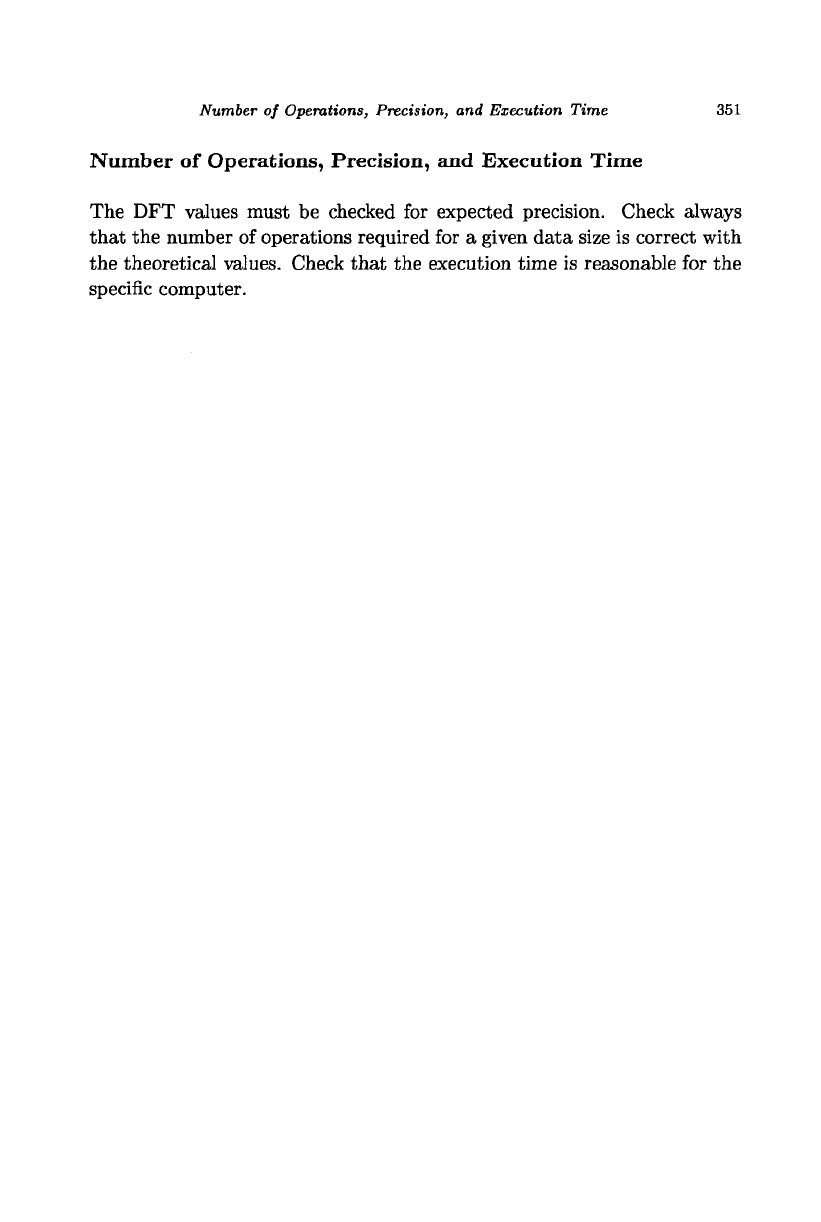
Number of Operations, Precision, and Execution Time 351
Number of Operations, Precision, and Execution Time
The DFT values must be checked for expected precision. Check always
that the number of operations required for a given data size is correct with
the theoretical values. Check that the execution time is reasonable for the
specific computer.

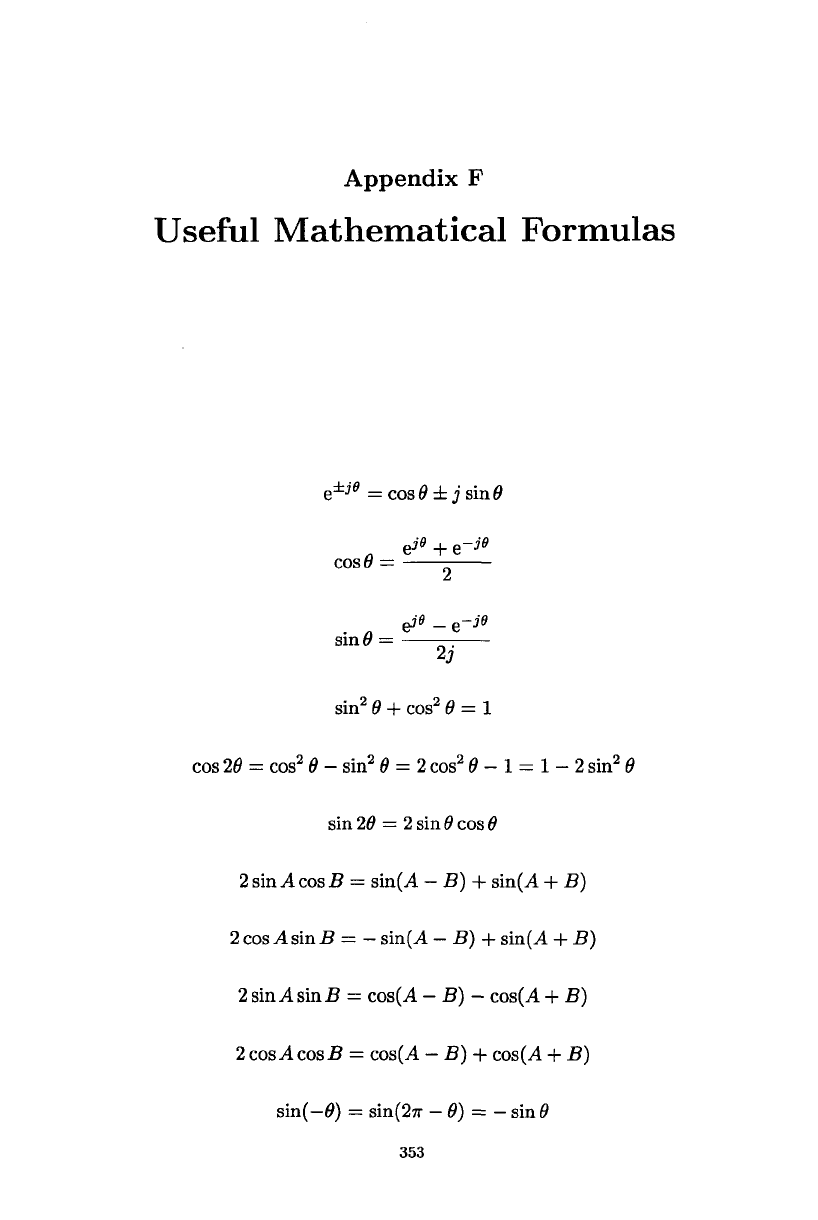
Appendix F
Useful Mathematical Formulas
e
±j0
=cos9±jsin9
cos 9 =
.
n
e»'
9
-e--»'«
sin 9 = —
sin
2
9 + cos
2
9 = 1
cos 19 = cos
2
9 - sin
2
9 = 2cos
2
0 - 1 = 1 -
2
sin
2
0
sin
29
=
2
sin
0
cos 0
2 sin A cos B = sin(A - B) + sin(A + B)
2 cos A sin B = - sin(A - B) + sin(A + B)
2 sin A sin B = cos(A - B) - cos(A + B)
2
cos
A cos B = cos(A - B) + cos(A + B)
sin(-0) = sin(27r - 9) = - sin
6
353
